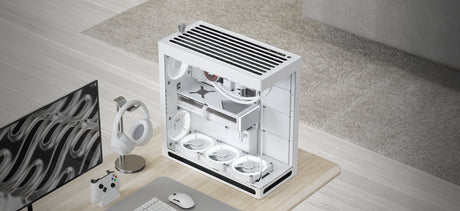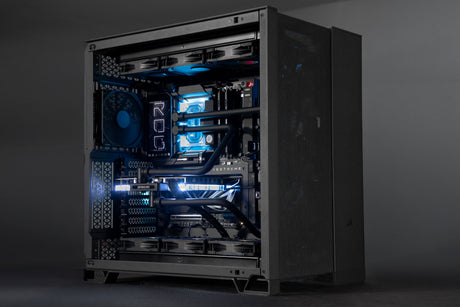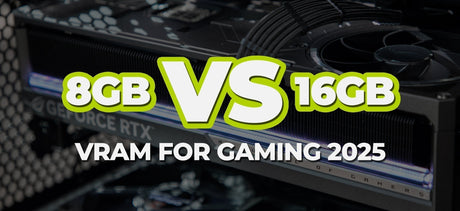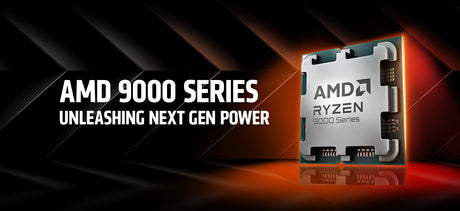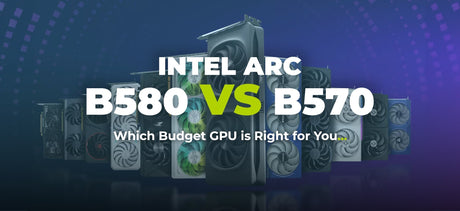If you’re in the market for a new GPU and trying to choose between an 8GB and 16GB model, you’re not alone. With so many choices like the RTX 4060, RTX 4060 Ti, and the new RTX 5060 and 5060 Ti series floating around, each with multiple VRAM configurations, it’s easy to feel overwhelmed. This guide will help clear things up, especially if you’re aiming for smooth gaming at 1080p or beyond.
VRAM Usage Is Climbing Fast
Modern games are evolving, and so are their memory demands. Titles like Cyberpunk 2077, Hogwarts Legacy, Resident Evil, Avatar, Ratchet and Clank: Rift Apart, and even upcoming releases are using more than 8GB of VRAM at 1080p when set to High or Ultra. This isn’t just about graphical fidelity, it directly impacts your gameplay experience.

We’re now in the twilight of the 8GB era. High settings at 1080p are sitting right on the cusp of exceeding that limit, and enabling features like ray tracing will push VRAM usage well beyond it.
An 8GB card may still run today’s games, but you’ll likely be forced to compromise, dropping settings or living with inconsistent performance. It's not just about texture quality; it's about avoiding stutters, frame drops, and frustrating 1% lows that kill immersion.
Opting for a 12GB or 16GB GPU gives you the breathing room needed for smoother gameplay now, and into the near future.
What Are 1% Lows and Why They Matter
When we talk about smooth gameplay, most people focus on average frame rates (FPS). But here’s the catch: averages can be misleading. That’s where 1% lows come in.

1% lows refer to the slowest 1% of frames during gameplay. In simple terms, it’s a measurement of the worst frame rates you’re likely to experience. If your GPU is hitting 100 FPS on average but dipping to 35 FPS during heavy moments, you’ll feel those drops, often as stutter, lag, or a jarring drop in responsiveness.
These dips are what break immersion. They can throw off your timing in fast-paced shooters, cause hitching during open-world exploration, or make your game feel inconsistent even if the FPS counter says otherwise.
Why does VRAM affect 1% lows?
When your GPU runs out of available VRAM, it has to offload data to system RAM or even your SSD, which is much slower. This creates bottlenecks that spike latency and lead to lower 1% lows. In contrast, a GPU with more VRAM (like a 16GB model) can store more texture data, shaders, and assets directly in memory, keeping performance smooth and consistent even in busy scenes.
In 2025, as more games push the limits of GPU memory, good 1% lows are the difference between "playable" and "enjoyable." If you're aiming for quality and consistency, pay attention to this metric.
8GB vs 16GB: Real World Performance Differences
Take the RTX 4060 Ti, which comes in both 8GB and 16GB versions. Benchmarks show that the 16GB model offers up to 25% - 30% better performance in VRAM-hungry titles, especially at 1440p and 4K, but even at 1080p it gives you noticeably better frame consistency.

The same goes for the new RTX 5060 Ti series, which comes in both 8GB and 16GB variants, something that understandably causes confusion for buyers. While both share the same name, the 16GB version isn’t just about having more memory; it unlocks a significantly better gaming experience. Thanks to the extra VRAM, the 16GB model can comfortably handle higher resolutions like 1440p. And that’s before you even factor in technologies like DLSS and Frame Generation, which can further extend its performance capabilities. Meanwhile, the 8GB version remains better suited for 1080p at Medium settings if you want smooth, consistent play.
(Please note that the use of Frame Generation will add more latency to your gameplay; controls will feel more laggy.)
Who Should Buy What?
Go with an 8GB GPU if:
- You’re a casual gamer
- You mainly play older or less demanding titles
- You’re happy running games at 1080p on Medium settings
- You’re on a tight budget and won’t be upgrading soon
Choose a 12GB or 16GB GPU if:
- You want to run modern titles at High or Ultra settings
- You’re aiming for 1080p with smoother gameplay, fewer stutters, and better 1% lows
- You plan to game at 1440p or higher
- You want more future-proofing
Why Are 8GB Cards Still a Thing?
It’s a fair question. With gaming requirements steadily rising, why are companies still pushing out 8GB GPUs? The short answer: budget segments and planned obsolescence. These cards are often targeted at prebuilt or entry-level systems with little room for upgrades. For the right buyer, someone who doesn’t mind turning settings down to medium at 1080p, they’re perfectly adequate. But for most gamers who want a quality experience now and later, 12GB to 16GB is the safer bet.
Final Thoughts: Think Long Term
The GPU you buy today isn’t just about today’s games, it’s your ticket to smooth, reliable performance for the next few years. With modern titles already demanding more than 8GB of VRAM even at 1080p High settings, skimping now could mean frustrating compromises and early upgrades later.

Sure, that 8GB card might look like a great deal today, but think about where you want your gaming experience to be 6 to 12 months from now. If you’re aiming for higher frame consistency, better visuals, and more future-proof value, then 12GB or 16GB is the smarter choice.
Whether you’re a casual gamer or chasing high-end performance, choosing the right GPU ensures your system stays relevant and capable. VRAM matters, not just for today’s needs, but for tomorrow’s demands.
Still unsure? Get in touch with us at Computer Lounge. Whether online or in-store, our team is here to help you pick the perfect GPU for your build, your games, and your goals.

